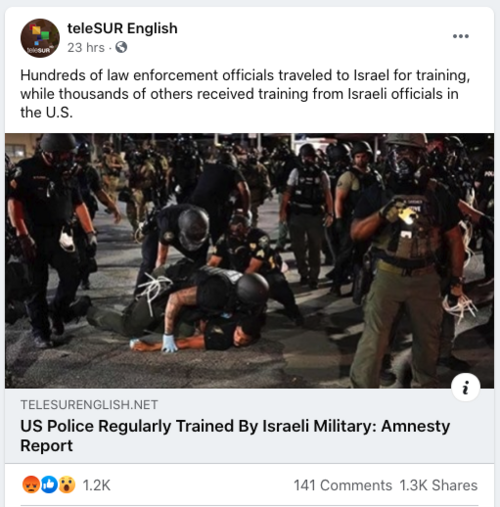Digital Street Conflict
Digital Street Conflict
A survey of spam, state and covert activities in the U.S. during domestic unrest.

Prologue: Disinformation Research in Crisis Situations
In today’s information ecosystem, anyone has the capability to run an influence campaign; the tools and techniques to distort the public’s perception of events at scale have been democratized. Domestic ideologues, spammers, and state actors have all been observed to take advantage of crisis events, to manipulate the discourse in service to their objectives.
In times of uncertainty and crisis, individuals increasingly turn to social media to make sense of events within their communities. This creates a rich opportunity for misleading or downright false narratives to manipulate captive audiences seeking information. The international attention to the protests that have erupted across the United States since the death of George Floyd – and the manipulative behaviors that have appeared in response – are one more example of this dynamic.
One difficulty for researchers observing these actors is measuring the non-linear impact of propaganda and disinformation. While it is easy to report original likes and shares, it is much harder to follow a story that grows legs and is repeated by high-follow-count users who remove direct connections to the original story source. Conversely, a piece of propaganda can have very large overall engagement numbers but have very little impact on the actual beliefs of those interacting with the content, especially if those interactions are mostly meant to criticize the content.
Academics, researchers and journalists have a special responsibility when informing the public about disinformation and propaganda, and this responsibility is heightened during moments of society-wide crisis. During times like these, we must be extremely careful attributing anonymous accounts to foreign actors. State actors have instigated and promoted real-world protests in the past, and continue to utilize both overt (state media, blue-check accounts) and covert (troll farms, commenter armies) capabilities to shape narratives and nudge audiences in particular directions. However, most of what we see is authentic, and domestic.
Responsible researchers and journalists should be equally careful when assigning impact to any discovered disinformation campaigns. This post will discuss some of the activity we have observed surrounding the protests in recent days, but it is important to reiterate that most played little role in creating the very real conflicts that are driving civil unrest.
We have seen no evidence, from our own research or the public research of others, to suggest that the current protests have been driven by misinformation or foreign actors instead of legitimate grievances.
Innovative Spam Tactics
While it may be tempting to dismiss spammers as inconsequential actors in online manipulation, they are often quite innovative and can achieve significant reach. During Saturday and Sunday’s protests, SIO worked with the Wall Street Journal to analyze a cluster of newly-created Facebook Pages (2019-2020). The Page owners, located in Pakistan and Vietnam, capitalized on the Live videos feature to attract new followers to their Pages. These pages did not show proprietary streams, but rather streamed cribbed videos of local protests created by local activists and passed off sensational old videos of protests and police brutality as current events. The account owners ran multi-hour Lives on Pages with names such as “USA Latest,” “Quarantine Radio,” and “USA Corona News.” These faked live streams topped search results for #JusticeForFloyd and ranked highly in searches for #BlackLivesMatter on Facebook. The videos amassed tens of millions of views and the pages gathered tens of thousands of followers. Their streams were shared into hundreds of Facebook Groups all over the world, presenting a misleading picture of what was actually happening live in America at the moment of viewing. Domestically, the distributors of Page content included several QAnon groups and a wide range of assorted communities with over 1 million followers.
 USA Latest’s Facebook Lives received high engagement; seven of its videos had over 1 million views. The Page also used verbatim text on their video descriptions, writing “the situation is getting really worse, Serious riots going on right now”. Page transparency shows three managers in Pakistan. Source: CrowdTangle.
USA Latest’s Facebook Lives received high engagement; seven of its videos had over 1 million views. The Page also used verbatim text on their video descriptions, writing “the situation is getting really worse, Serious riots going on right now”. Page transparency shows three managers in Pakistan. Source: CrowdTangle.
Covert Activity
We believe the spammer activity was primarily economically motivated. Politically-motivated covert activity executed by state governments or contractors is significantly harder to detect. While researchers may observe content from dubious-looking accounts going viral, making an attribution is a significant challenge that requires outside researchers to coordinate with platforms, civil society, or government entities with visibility into other operational indicators that can provide corroboration beyond behavior.
An illustrative example of this challenge is a rumor that went viral by way of a tweet from an account claiming to be an antifa account (@ANTIFA_US). On May 31st at 1:00 pm, the account tweeted a threat to suburban communities (screenshot below). Screenshots spread widely on a number of platforms, and many people expressed deep concern. Other users on Twitter, meanwhile, were skeptical and suggested it was tied to Russia.

Official attribution came nearly 24 hours after the tweet went out. Twitter attributed the account to a far-right group by the name of Identity Evropa, and took down the account.
This example speaks to the challenge of attribution: even if something is believed to be misleading or manipulative, understanding who is behind the manipulation is a time-consuming process. Unfortunately, time is often in short supply. In addition to the several hundred retweets on Twitter, the post appeared hundreds more times on Facebook, including on influencer pages with hundreds of thousands of followers. Additionally, concerned people texted it to their friends; this direct messaging happens outside of the reach of fact-checking interstitials and platform downranking.
State Media Reaction
So what is clearly attributable to state actors? We examined social media accounts for state owned media broadcast properties and as accounts run by embassies and government ministers. However, very little of the information that we have observed these accounts promoting would count as mis- or disinformation – it is criticism of real events in the U.S., even if slanted.
As part of the Virality Project, we are observing state media from China, Iran, Russia and Venezuela, all countries with strong international propaganda arms. There are several themes common across these countries; sometimes, they share each other’s content. They focus primarily on hypocrisy, highlighting police brutality and violence in response to the protests:
- “The U.S. cannot even govern itself, how can it claim to be able to tell other countries what to do?”
- “Donald Trump is cowering in a bunker while cities burn”
- “The U.S.’s response to the protests shows they have double standards, especially with regard to Hong Kong”
- “The U.S. doesn’t respect human rights and press freedom and has no right to lecture other countries”
China
The U.S. protests have been prominently featured by Chinese state media. CGTN Arabic ran the headline, “Do you care about black Americans losing their lives?” Other Chinese state media outlets ran Facebook ads comparing the U.S. and Hong Kong protests. A May 27th Global Times video suggested that the U.S. was guilty of a double standard in supporting the protesters and violent demonstrations in Hong Kong, while expecting peaceful protests domestically. In one notable exchange, China's Ministry of Foreign Affairs tweeted “I can’t breathe” with a screenshot of a tweet from a State Department spokesperson supporting anti-government protests in Hong Kong:
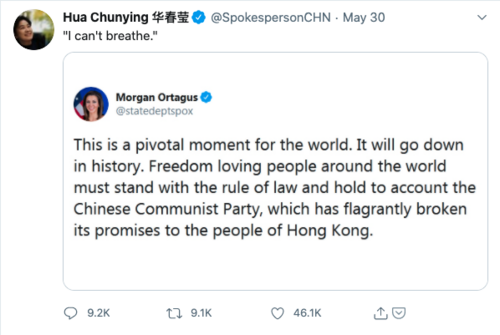
Outlets such as Global Times framed the U.S. protests as an example of: 1) the U.S. double standard on protests in Hong Kong; and 2) how little the U.S. cares about the poor and marginalized, using this material in ad collateral:

Iran
Iranian state media on Facebook have primarily focused on narratives presenting American police as fascists, although post volume is low. State media have amplified government officials and state agencies via Twitter, targeting their messaging directly to American people, appealing to the public’s sense of deep-seeded injustice. The U.S. routinely cites Iran’s press censorship and treatment of journalists as a human rights violation; the Iranian Foreign Ministry tweeted out the below image to lob the same accusation back. Another image of Iranians holding a vigil for George Floyd has been widely shared on Twitter and Facebook.
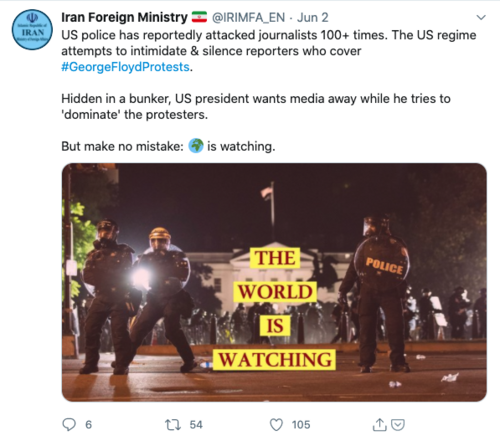
Supreme Leader Ayatollah Khamenei posted videos to his Twitter page speaking directly to Black Americans and highlighting the history of systemic racism. He also tweeted a similar message from his Spanish-language account, adding “these are the words of the president of the U.S. This is the racism of the U.S.”
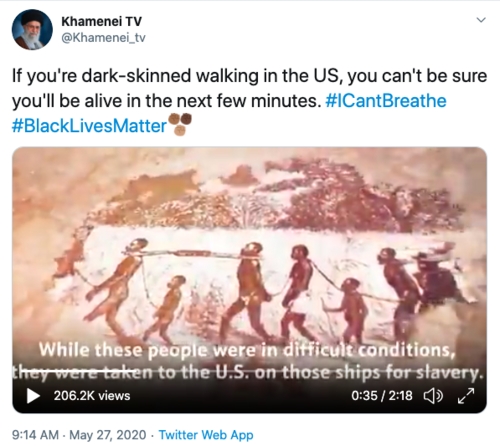
Iranian Foreign Minister Javad Zarif was more blunt in his posts, directly calling out to European nations to consider the U.S. police violence against Black Americans and protestors before publicly condemning Iran for human rights abuses. Another tweet featured a red-lined copy of a State Department press release from June 2018 that condemned the Iranian regime’s response to public protests.

Russia
The civil unrest in the U.S. is a windfall for Russian state media, whose primary goal is to subvert its ideological foes. They have leapt at the opportunity to push their narratives that the U.S. is a broken, soulless, and hypocritical country. Russia’s propaganda operation is unique among state media properties in that it actively appeals to viewpoints on both ends of the political spectrum.
In general, official outlets such as RT and Sputnik tend to stick to more popular messaging — they can achieve their aim of undermining U.S. morale simply by showing what’s happening.
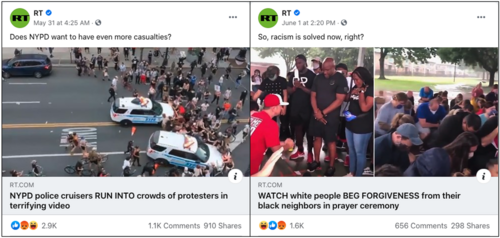
The Russian Embassy deployed the media opportunism, accusing U.S. law enforcement of targeting journalists. This critique is ironic given the Russian govenment's track record of silencing journalists.

Russian’s overt state media leave more inflammatory messaging to Russia-aligned websites with partisan followings and GRU persona content, as shown in the headlines below from Global Research and The Duran:
 Top: Global Research, June 1, 2020; Bottom: The Duran, June 3, 2020
Top: Global Research, June 1, 2020; Bottom: The Duran, June 3, 2020
The largest audiences for Russian state media abroad are actually in Latin America and the Middle East. RT and Sputnik’s messaging for these audiences is consistent: the U.S. is a broken country, due in part to its own misdeeds around the world, and it should not be able to claim a leadership position in world affairs.
 Posts appearing on the Facebook Pages for Sputnik Turkey (left) and Sputnik Lithuania (right)
Posts appearing on the Facebook Pages for Sputnik Turkey (left) and Sputnik Lithuania (right)
Venezuela
The Venezuelan media coverage of the protests emphasized repeatedly that the U.S. is a racist country. Venezuelan president Nicolas Maduro self identifies as of mixed race and a significant portion of the Venezuelan population has African ancestry so highlighting racism in the U.S. is a common trope to build the regime’s moral high-ground. Maduro retweeted multiple RT posts highlighting this theme. The U.S. has also been critical of the Maduro regime’s human rights and criminal records, so the opportunity to turn those critiques back on the Trump administration could not be passed up. The Venezuelan Minister for External Relations tweeted in both English and Spanish mocking Secretary of State Pompeo for hiding in a bunker.
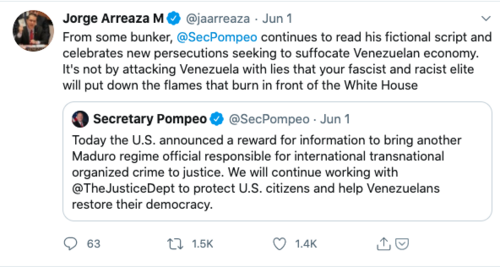
State media outlet teleSUR posted an article quoting the chief spokesman for the Iranian Armed Forces calling the U.S. a “democratic fallacy.” VTV wrote “Russia warns that the U.S. has no authority to talk about human rights after the assassinations committed by its police.” These posts served the dual purpose of promoting the Venezuelan regime’s few allies while criticizing its largest enemy.

Finally, teleSUR English shared a story with the headline “US Police Regularly Trained By Israeli Military.” The post did not have very high engagement (only 3k engagements on Facebook by 6/2 according to crowdtangle), but the messaging is notable and the story was shared in several anti-Israel / pro-Palestine Groups and Pages.
